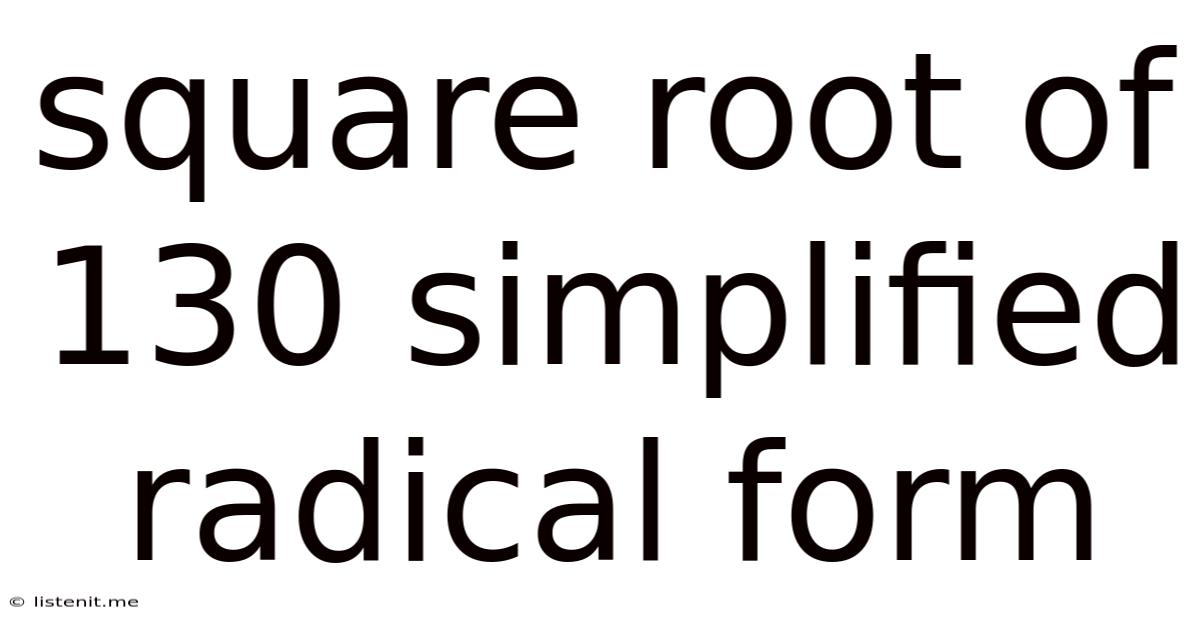Square Root Of 130 Simplified Radical Form
listenit
May 10, 2025 · 4 min read

Table of Contents
Simplifying the Square Root of 130: A Comprehensive Guide
The square root of 130, denoted as √130, is an irrational number. This means it cannot be expressed as a simple fraction and its decimal representation goes on forever without repeating. However, we can simplify it to its simplest radical form, making it easier to work with in mathematical calculations. This article provides a thorough exploration of simplifying √130, covering various methods and related concepts, equipping you with a comprehensive understanding of the process.
Understanding Radicals and Simplification
Before diving into the simplification of √130, let's review some fundamental concepts related to radicals. A radical is an expression that involves a root, such as a square root (√), cube root (∛), or higher-order roots. Simplifying a radical means expressing it in its most concise form, eliminating any perfect square factors from within the radical. This process is crucial for efficient mathematical operations and clearer representation.
Perfect Squares and Factors
The key to simplifying radicals lies in identifying perfect squares. A perfect square is a number that results from squaring an integer (e.g., 4 is a perfect square because 2² = 4). When simplifying a radical, we look for factors within the radicand (the number under the radical symbol) that are perfect squares. We can then extract these perfect squares as whole numbers outside the radical.
For example, consider √12. We know that 12 can be factored as 4 x 3, where 4 is a perfect square (2²). Therefore, √12 can be simplified as follows:
√12 = √(4 x 3) = √4 x √3 = 2√3
Simplifying the Square Root of 130
Now, let's tackle the simplification of √130. The first step involves finding the prime factorization of 130. Prime factorization breaks down a number into its prime factors, which are numbers divisible only by 1 and themselves.
The prime factorization of 130 is 2 x 5 x 13. Notice that none of these factors are perfect squares. This means that √130 cannot be simplified further into a form involving whole numbers outside the radical.
Therefore, the simplest radical form of √130 is √130.
It's important to understand that this doesn't mean the number is inherently "unsimplified". It's simply in its most concise radical form. There are no perfect square factors to extract. Attempting further simplification would lead to an approximation using decimal values, losing the exact mathematical representation.
Approximating √130
While we cannot simplify √130 to a simpler radical form, we can approximate its decimal value. Using a calculator, we find that:
√130 ≈ 11.40175425
This approximation is useful for practical applications where an exact value isn't strictly necessary. However, remember that this is an approximation, and the exact value remains √130.
Working with √130 in Equations
Even though √130 remains in its simplest radical form (√130), it can still be incorporated into various mathematical equations and operations. For instance:
-
Addition/Subtraction: If you have expressions like 2√130 + 3√130, you can combine them to get 5√130. This works only if the radicands (the numbers inside the square roots) are the same.
-
Multiplication: Multiplying √130 by another radical is straightforward. For example, √130 * √2 = √(130 * 2) = √260. You would then need to simplify √260, if possible, by finding its prime factorization and extracting any perfect square factors.
-
Division: Division is similar to multiplication. √130 / √5 = √(130/5) = √26. Again, simplification might be possible depending on the result.
Advanced Concepts and Related Problems
Understanding the simplification of √130 provides a foundation for tackling more complex problems involving radicals. Here are some advanced concepts and related problems to further your understanding:
Higher-Order Roots
The concepts discussed above extend to higher-order roots, such as cube roots (∛), fourth roots (∜), and so on. The process involves finding perfect cube factors, perfect fourth factors, etc., within the radicand.
Rationalizing the Denominator
In some cases, you might encounter expressions with radicals in the denominator of a fraction. Rationalizing the denominator involves manipulating the expression to remove the radical from the denominator. This generally involves multiplying the numerator and denominator by the conjugate of the denominator.
Solving Equations with Radicals
Radical equations involve variables within radicals. Solving these equations requires careful manipulation and often involves squaring or raising both sides of the equation to an appropriate power. Remember to always check your solutions to avoid extraneous roots (solutions that don't satisfy the original equation).
Conclusion: Mastering Radical Simplification
Simplifying radical expressions is a crucial skill in algebra and beyond. While √130 cannot be simplified beyond its simplest form (√130), understanding the process of finding prime factors and identifying perfect squares is essential for simplifying other radicals. This article provided a comprehensive guide, illustrating the process and extending the concepts to more advanced scenarios. Mastering these techniques will significantly improve your ability to work efficiently with radical expressions in various mathematical contexts. Remember that even if a radical cannot be simplified further, understanding its fundamental properties remains crucial for effective mathematical manipulation and problem-solving.
Latest Posts
Latest Posts
-
Difference Between A Biome And A Habitat
May 10, 2025
-
What Is 1 2 3 As An Improper Fraction Weegy
May 10, 2025
-
What Is The Total Surface Area Of This Rectangular Pyramid
May 10, 2025
-
What Is Salt On The Periodic Table Of Elements
May 10, 2025
-
Why Do Nonmetals Form Covalent Bonds
May 10, 2025
Related Post
Thank you for visiting our website which covers about Square Root Of 130 Simplified Radical Form . We hope the information provided has been useful to you. Feel free to contact us if you have any questions or need further assistance. See you next time and don't miss to bookmark.